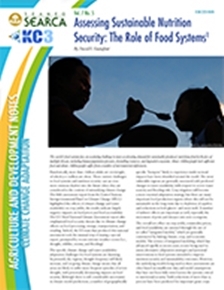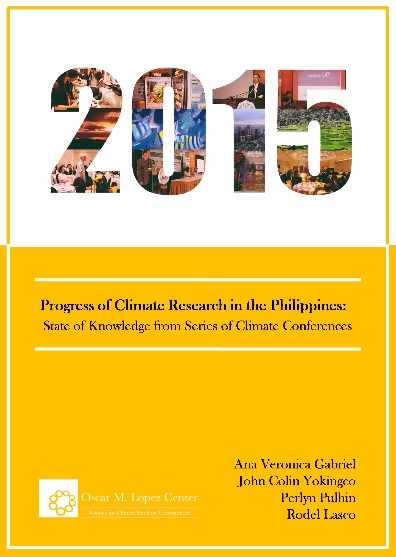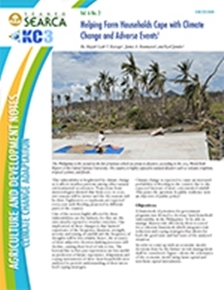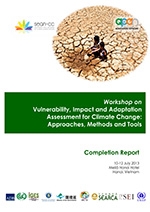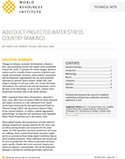Publications
This contains experience notes, adaptation notes, policy briefs, policy papers, technical reports, stories on good practices, and other publications related to climate change adaptation and mitigation in Southeast Asia not just from SEARCA, but also from KC3's partners and other agencies/institutions.
ADB is working with leading clean technology accelerators, incubators, and start-ups across Asia to promote more efficient use and management of energy and natural resources. ADB’s Climate Technology Finance Center seeks to accelerate clean technology entrepreneurship and investment in Asia by supporting activities, programs, and partnerships that aim to produce more investable cleantech, more risk capital for cleantech, increased cleantech knowledge, and a stronger cleantech ecosystem.
The world's food systems face an escalating challenge to meet accelerating demand for sustainably-produced, nutritious food in the face of multiple threats, including human population pressure, dwindling resources, and degraded ecosystems. About 1 billion people lack sufficient food and about 2 billion people suffer from a number of micronutrient deficiencies. Paradoxically, more than 2 billion adults are overweight, of which 500 million are obese. These current challenges to food systems and nutrition security cast an even more ominous shadow into…
It is evident that the Philippines is bearing the brunt of climate change, making it crucial to adapt at a pace comparable with the increasing impacts of the changing climate. Recognizing the value of research and science in drawing long-term and sustainable solutions to climate change issues, the National Academy of Science and Technology (NAST) - Philippines holds an annual national climate conference to discuss the climate knowledge in the country and determine the gaps in climate-related research and policies.…
Analysis of agriculture in countries’ climate change mitigation and adaptation strategies finds: Most Parties to the UNFCCC include agriculture in their mitigation targets (80%) and adaptation strategies (64%); Non-annex 1 Parties note the need for international financial support to implement their INDCs and raise the ambition of their contributions; For countries to meet their targets, climate finance will need to address agriculture.
After two weeks of negotiations, nearly 200 nations have finally agreed on a global climate change agreement to replace the nearly expired Kyoto Protocol. The Paris Agreement – which aims to limit the increase in global average temperatures to “well below two degrees C” and to pursue efforts to limit it to 1.5 degrees C – will come into force in 2020, and has already been hailed as historic and ambitious by many world leaders. Though agriculture is not mentioned by name,…
The Philippines is the second on the list of nations which are prone to disasters, according to the 2014 World Risk Report of the United Nations University. The country is highly exposed to natural disasters such as volcanic eruptions, tropical cyclones, and floods. This vulnerability is heightened by climate change as it affects weather patterns among other natural environmental occurrences. Projections from meteorologists showed that from 2020 to 2050, wet seasons will be wetter and the dry seasons will be…
From 1990 to 2010, carbon dioxide (CO2) emissions in Southeast Asia have grown more rapidly than in any other region of the world. The Asian Development Bank (ADB) has analyzed the potential role the region can play in climate change mitigation, focusing on the five countries of Southeast Asia that collectively account for 90% of regional greenhouse gas (GHG) emissions—Indonesia, Malaysia, the Philippines, Thailand, and Vietnam.
Twelve technical officers and two executives from the focal Climate Change offices of seven Southeast Asian countries completed the workshop on Vulnerability, Impact and Adaptation Assessment (VIAA) for Climate Change: Approaches, Methods, and Tools on 10-12 July 2013 at Meliá Hanoi Hotel, Hanoi, Vietnam. The officials and technical staff come from Cambodia, Indonesia, Lao PDR, Malaysia, Philippines, Thailand, and Vietnam and belong to the Southeast Asian Network of Climate Change Offices (SEAN-CC) of the United Nations Environment Program (UNEP). Co-organized…
Changes in climate, economic development, urbanization, and population growth will impact water availability around the world. To prepare for these changes, decision-makers need to consider future scenarios of global water supply and demand. Investors, policymakers, companies, and development organizations can use such projected estimates to quantify future impact, hedge risks, and adapt to changes at relevant scales. For certain decisions and analysis, the national scale may be important, and to the best of our knowledge, no up-to-date, country-level projections currently…
The tool for understanding resilience of fisheries (VA-TURF) is a practical and cost-effective tool for assessing the climate change vulnerability of coastal fisheries in the tropics (Mamauag, Aliño, Martinez, Muallil, Doctor, Dizon, Geronimo, Panga, and Cabral 2013). Developed by local marine scientists at the Marine Science Institute of the University of the Philippines Diliman, VA-TURF aims to identify vulnerable fishing communities and demonstrates how to link vulnerability assessment results to climate change adaptation. The results are inputs to drafting of…


